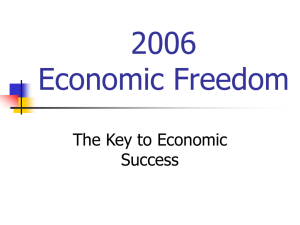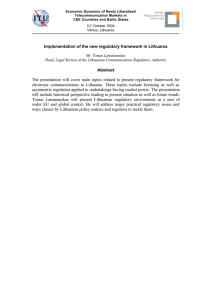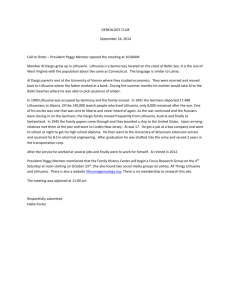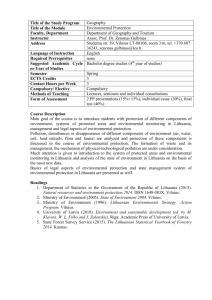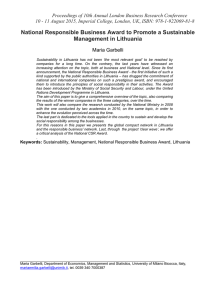A General Assembly
advertisement
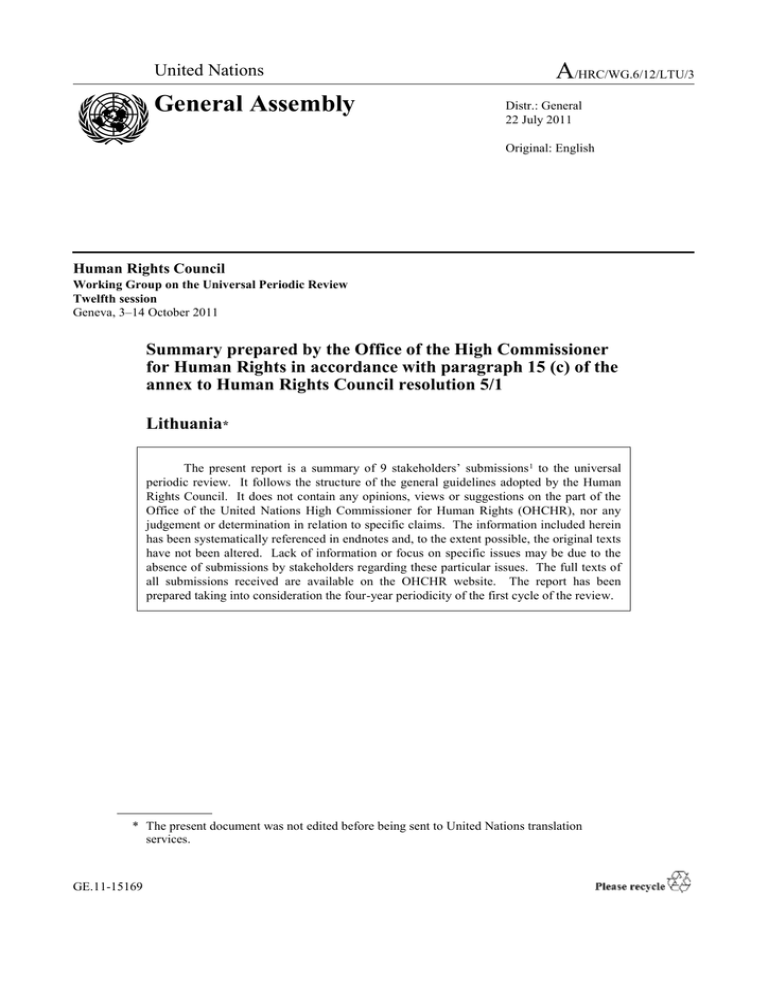
United Nations General Assembly A/HRC/WG.6/12/LTU/3 Distr.: General 22 July 2011 Original: English Human Rights Council Working Group on the Universal Periodic Review Twelfth session Geneva, 3–14 October 2011 Summary prepared by the Office of the High Commissioner for Human Rights in accordance with paragraph 15 (c) of the annex to Human Rights Council resolution 5/1 Lithuania* The present report is a summary of 9 stakeholders’ submissions 1 to the universal periodic review. It follows the structure of the general guidelines adopted by the Human Rights Council. It does not contain any opinions, views or suggestions on the part of the Office of the United Nations High Commissioner for Human Rights (OHCHR), nor any judgement or determination in relation to specific claims. The information included herein has been systematically referenced in endnotes and, to the extent possible, the original texts have not been altered. Lack of information or focus on specific issues may be due to the absence of submissions by stakeholders regarding these particular issues. The full texts of all submissions received are available on the OHCHR website. The report has been prepared taking into consideration the four-year periodicity of the first cycle of the review. * The present document was not edited before being sent to United Nations translation services. GE.11-15169 A/HRC/WG.6/12/LTU/3 I. Background and framework A. Scope of international obligations 1. Joint Submission 1(JS1) indicated that Lithuania had not signed the Optional Protocols to the International Covenant on Economic, Social and Cultural Rights (ICESCR) and to the Convention against Torture and Other Cruel, Inhuman or Degrading Treatment or Punishment (CAT),2 and that it had not ratified the International Convention on the Protection of the Rights of All Migrant Workers and Members of Their Families (ICRMW).3 JS1 noted that Lithuania had not acceded to Article 14 of the International Convention on the Elimination of All Forms of Racial Discrimination (ICERD) on individual complaints4 2. JS1 noted that upon ratification of the Convention on the Rights of Persons with Disabilities (CRPD), Lithuania made a declaration on its interpretation of the concept of “sexual and reproductive health” (Article 25a).5 B. Constitutional and legislative framework 3. JS1 indicated that under the Constitution, both the International Covenant on Civil and Political Rights (ICCPR) and ICESCR were constituent parts of the Lithuanian legal system; however their status within the system remained ambiguous, as it was unclear whether in case of conflict of norms the Covenants would prevail. 6 4. JS1 noted that the right to bring cases before the Constitutional Court could only be exercised by the Government, Parliament, courts and President in certain cases. In 2007, Parliament approved the general idea of an individual constitutional complaint which was expected to be introduced in 2009. In fact, it had been postponed indefinitely.7 C. Institutional and human rights infrastructure 5. JS1 noted the existence of a number of independent institutions such as the Equal Opportunity Ombudsperson Office, the Children’s Ombudsperson, and the Inspector for Journalists’ Ethics. It noted however that none of the institutions had a sufficiently broad human rights mandate and did not fulfil requirements to be accredited as a National Human Rights Institution.8 Joint Submission 5 (JS5) encouraged the Equal Opportunities Ombudsperson to be more proactive in combating discrimination and initiating political debate on LGBT rights.9 6. Joint Submission 3 (JS3) reported that the gender equality machinery had been disempowered and a separate Gender Equality Division at the Ministry of Social Security and Labour was closed. It was concerned that gender equality issues had been removed from the agenda of State policies.10 7. JS1 indicated that no institution was concerned with regard to international human rights systems, in terms of encouraging ratification of treaties, making observations known or in following up on recommendations adopted. 11 JS1 added that existing institutions had weak, if any, links to civil society. 12 2 A/HRC/WG.6/12/LTU/3 D. Policy measures 8. The Council of Europe’s Commissioner for Human Rights (CoE Commissioner) noted that the national anti-discrimination programme for 2006-2008 aimed at investigating manifestations of discrimination in all areas of public life, including raising the public’s tolerance, and improving public awareness about non-discrimination, equal treatment, equal rights and opportunities.13 9. Joint Submission 2 (JS2) indicated that since 2005 a National Programme for Prevention of Violence against Children and Assistance for Children was being implemented. It provided for abuse prevention programmes, victim support and other protection measures.14 10. Joint Submission 6 (JS6) noted the Child Health Promotion Program for 2008-2012 in which children's early sexual relations and pregnancy were identified as particularly serious concerns. However, the plan contained no specific measures that would improve adolescent sexual reproductive health. 15 JS6 also noted the Strategy of the State Policy on Child Welfare for 2005–2012, but expressed concern that it did not help teenagers to deal with issues concerning their sexual and reproductive health. 16 11. Joint Submission 4 (JS4) highlighted the Programme of the Integration of Roma in Lithuanian Society for 2008-2010, which was aimed at improving Roma unemployment and education, reduction of poverty and fighting social exclusion. However, the programme received only 16 per cent of its initial budget and was discontinued in June 2010. The main institution responsible for its implementation, the Department of National Minorities, was dissolved and ceased to exist.17 II. Promotion and protection of human rights on the ground A. Cooperation with human rights mechanisms Cooperation with treaty bodies 12. JS1 stated that concluding observations by human rights bodies are not disseminated beyond certain State institutions, and public awareness about them is low. 18 B. 1. Implementation of international human rights obligations Equality and non-discrimination 13. JS3 noted that inadequate responses of law enforcement institutions created conditions for the outburst of xenophobia, racism and anti-Semitism. The situation of the Roma was particularly alarming because of the discriminatory behaviour of the police towards them; JS3 added that the police, which was the main pre-trail institution, rarely started pre-trial investigations on these issues.19 14. JS3 also observed that it was disturbing that the courts required an exclusively high standard of proof for racial or ethnic discrimination crimes and tended to misinterpret the case-law of the European Court of Human Rights. The Lithuanian case-law tended to demonstrate that public incitement against any racial, ethnic, religious or other group of persons was conceived as a minor crime. On 25 May 2009, the Supreme Court rejected an appeal of the Prosecutor’s office concerning the acquittal of a person who had advocated violence against the Roma in one news portal. The court declared that not every negative statement about a person or group of persons belonging to particular groups constituted a 3 A/HRC/WG.6/12/LTU/3 criminal offence. Moreover, the court found a lack of direct intent to incite hate. In addition, the court ruled that different standards should be applied depending on whether expression was a fact or a value judgment.20 15. AI highlighted that, Article 39 of the 2010 Law on Provision of Public Information stated that advertising and audiovisual communication “must not contain any manifestation or promotion of sexual orientation.” 21 JS5 stated that this Law was obviously meant to restrict information and “promotion” of homosexual relationships and that it would be used against LGBT related information.22 JS5 recommended that Lithuania remove the discriminatory article from this Law; and ensure that public information served to enhance equality, tolerance and respect for human rights for all, including LGBT people. 23 2. Right to life, liberty and security of the person 16. The European Committee for the Prevention of Torture and Inhuman or Degrading treatment or Punishment (CPT) reported on allegations of physical ill-treatment during questioning by officers of the criminal police. It appeared that juveniles were particularly at risk in this respect. CPT further noted that some persons alleged ill-treatment of a psychological nature, such as verbal abuse or threats to use violence. A few allegations were received concerning the excessive use of force at the time of apprehension, after the person concerned had been brought under control. 24 CPT called upon Lithuania to redouble efforts to combat ill-treatment by the police and recommended that police officers be reminded, at regular intervals, that all forms of ill-treatment of persons deprived of their liberty were not acceptable and would be the subject of severe sanctions.25 Regarding allegations of ill-treatment inflicted by staff at some of the prisons, CPT recommended that a clear message be delivered that all forms of ill-treatment of prisoners were unacceptable and would be dealt severely. 26 CPT recommended that Lithuania pursue efforts to address the problem of inter-prisoner violence.27 17. CPT received a number of allegations that prosecutors and judges did not act upon claims of ill-treatment when these were brought to their attention. CPT recommended Lithuania to ensure that prosecutorial and judicial authorities take resolute action when any information indicative of ill-treatment emerged. Allegations and/or other information indicative of ill-treatment should be adequately assessed. 28 18. CPT reiterated its recommendation that steps be taken to ensure that all prisoners have adequate quantities of essential personal hygiene products. 29 CPT noted that material conditions in some of detention centres displayed a number of major shortcomings and could in some cases be considered inhuman and degrading. CPT called upon Lithuania to step up efforts to bring conditions of detention to an acceptable level. 30 19. JS4 noted that violence against women remained a key problem in Lithuania. Police statistics showed the high prevalence of violence, particularly domestic violence, against women. In 2009, the police registered 41,982 calls on domestic violence; however, it initiated only 737 pre-trial investigations. Furthermore, 19 women were killed by their spouse or intimate partner. JS4 stated that domestic violence was covered by the general provision of the Criminal Code as interpersonal violence and that the existing legal and procedural framework to fight domestic violence was ineffective. In general the support possibilities of the victims of domestic violence were limited. There were very few shelters that were supported from the municipal budget. Many NGOs that ran shelters or crises centres should annually apply for funds. JS4 added that there was no 24 hours hotline yet, and that the hotline funded from the state budget worked only during daytime, excluding weekends.31 20. JS2 stated that despite many efforts in the field of human trafficking the situation remained lamentable.32 CoE Commissioner noted that the new Criminal Code provided for 4 A/HRC/WG.6/12/LTU/3 stricter sentences for perpetrators, although the number of cases leading to conviction remained low. Among main concerns were the lack of an overall rehabilitation programme for victims of trafficking and lack of possibility to be compensated. CoE Commissioner recommended that firm measures be developed against trafficking in human beings and that increased attention be given to prosecuting the criminal networks while protecting victims of trafficking.33 21. JS2 stated that police officers and prosecutors lacked competence and specialized knowledge in treating victims of sexual abuse. It added that the police treated victims as criminals. It also indicated that residential institutions as well as social risk families failed to report missing children.34 JS2 noted the lack of institutional competence to recognize child abuse and evaluate risks. It indicated that only NGOs incidentally developed guidelines for multi-disciplinary cooperation in child abuse cases. 35 JS2 stated that continuous long-term financing was necessary to provide effective victim support. It was concerned that many of victims did not know what help they were entitled to and how to get it.36 22. The Global Initiative to End All Corporal Punishment of Children (GIECPC) noted with concern that corporal punishment was lawful in the home and that there was no explicit prohibition of corporal punishment in schools and alternative care settings. It added that in the penal system corporal punishment was unlawful, but was concerned that there was no explicit prohibition in law. 37 3. Administration of justice and the rule of law 23. JS1 stated that pre-trial investigations in criminal cases were often conducted unprofessionally. A particular problem was the disproportionate use of arrests and detentions on remand at the pre-trial phase of criminal proceedings. Pursuant to the Code of Criminal Procedure, the proportionality principle must be adhered to in the application of coercive measures during pre-trial investigation. However, quite often a person suspected of a minor crime was arrested for 48 hours, as allowed by law, and then simply released after this period expired since there were no grounds for going to court for the authorisation of detention on remand. The appeal procedure against the arrest was ineffective and very few complaints were lodged against the legality of arrests. 38 JS1 stated that even though detention on remand was to be used only as a last resort, it was the standard measure. 39 CPT recommended that Lithuania review the system of remand detention in police detention centres to substantially reduce its duration. 40 24. JS1 noted that the Law on State-Guaranteed Legal Aid provided for two types of legal aid: primary –consultation and drafting of certain requests- and secondary – preparation of court cases and legal representation. It stated that the eligibility criteria for secondary legal aid were unclear. Frequently, potential beneficiaries were lacking information about the State-guaranteed legal aid, particularly individuals with disabilities, individuals who did not understand or speak the Lithuanian language, and detained persons.41 CPT called upon Lithuania to ensure that the right of access to a lawyer be enjoyed by all persons. CPT recommended that Lithuania ensure the effectiveness of the legal aid system for persons in police custody who were not in a position to pay for a lawyer.42 25. CoE Commissioner stated that the 2005 Law on Equal Treatment did not provide that the burden of proof should lay on the defendant, and that the possibility for compensation of victims of discrimination should be provided by this Law. 43 CoE Commissioner recommended a strengthening of the Law on Equal Treatment. 44 26. JS2 noted that in recent years important achievements were made to improve the conditions of children in legal procedures. It highlighted existing gaps in the system, e.g. 5 A/HRC/WG.6/12/LTU/3 there were no specialized judges, prosecutors and police officers, dealing with child abuse cases and criminal investigations were implemented by criminal police officers dealing with all kinds of violent crimes with young and adult victims. 45 27. JS2 stated that forensic interviews were one of the core procedures in legal proceedings. It noted that Article 186 of the Penal Procedures Code stated that juveniles were interviewed once; the judge could forbid participation of the suspect in a child’s interview, if his/her participation could affect the child; a child could be interviewed in a separate environment from other process participants. It noted however that the provisions of this article were not sufficient. In 2002, 2008 and 2009 the General prosecutor issued orders regulating legal procedures related to children victims and witnesses. Unfortunately, these regulations had not been implemented properly. 46 28. CPT noted that if the criminal suspect was a juvenile, the parents had to be notified immediately, even when the juvenile did not request this. However, it appeared that in practice parents were usually notified after the “protocol of apprehension” was drawn up. CPT recommended that steps be taken to ensure that juveniles did not make any statement or sign any document relating to the offence of which they were suspected without the benefit of a lawyer and ideally a trusted adult being present to assist them.47 29. CPT was concerned to observe that a juvenile remand prisoner at Šiauliai City Police Headquarters had been kept in a cell together with two adults for over a week. As previously stressed by CPT, such a situation was unacceptable. CPT reiterated its recommendation that immediate steps be taken to ensure that juveniles placed in police detention facilities were accommodated separately from adult detainees. 48 4. Right to privacy, marriage and family life 30. JS3 noted that Lithuania recognized one’s right to change gender and civil status, however, it noted that there was no law providing for the conditions and procedures of full gender reassignment, nor for procedures of the change of civil-status documents.49 31. JS3 noted that in June 2008, the Parliament adopted the Conceptual Framework for National Family Policy. It stated that this Framework provided for a concept of family limited to married heterosexual couples with children. Such a narrow perception of the family embodied a systematic discrimination against cohabitating couples with children, single parents and homosexual families. Moreover, it did not provide equal legal protection for children born out of wedlock and had a negative impact on women’s enjoyment of their human rights in marriage and family relations. Since 2008 Parliament had initiated a number of legal acts relying on the provisions of this Framework and consequently reinforced stigmatization, exclusion and discrimination of persons beyond the restricted concept of family definition. It noted that the Law on Partnership had not been adopted yet and thus, cohabitating couples, both heterosexual and homosexual, could not legally register their civil partnership. As a result, legal acts such as property regulations, social benefits and child adoption, provided different treatment to persons in marriage and cohabitating partners.50 5. Freedom of religion or belief, expression, association and peaceful assembly 32. JS4 noted that the Law on Religious Communities and Associations provided that there was no State religion in Lithuania. It indicated that following the 2007 decision of the Constitutional Court, traditional and state-recognized non-traditional religious associations and communities did not enjoy equal rights. It noted that the State granted a number of privileges to the traditional religious communities, such as annual State subsidies, while non-traditional groups were eligible for government support only for their cultural and social projects. It stated that there was no law which would enable the Jewish community to 6 A/HRC/WG.6/12/LTU/3 act according to the Jewish tradition. It stated that it was impossible to join Jewish religious communities into one because of the different legal forms. 51 33. Amnesty International (AI) indicated that the 2010 Law on the Protection of Minors against the Detrimental Effect of Public Information classified as detrimental to children any information which “denigrated family values” or encouraged a concept of marriage other than the union of a man and a woman, and consequently banned such information from places accessible to children.52 AI was concerned that the law could be used to restrict freedom of expression of lesbian, gay, bisexual and transgender people (LGBTs) and advocates for their rights.53 AI called on Lithuania to revise this law to remove all possibilities of it being applied in a manner that stigmatised or discriminated against LGBTs or violated their rights to freedom of assembly and expression; and to refrain from legislative initiatives which would criminalize homosexual relations. 54 34. JS555 and AI56 noted that the Parliament adopted legislative amendments in 2010 to the Code on Administrative Offence which would criminalize the “promotion of homosexual relations in public places”.57 JS5 urged Lithuania to reject discriminatory law initiatives and ensure freedom of expression for all, including LGBT people, and encourage a constructive public and political debate on the rights of LGBT people.58 35. JS5 referred to a number of events planned for 2007 encouraging tolerance towards lesbian and gay workers which were not permitted in Vilnius including the ‘antidiscrimination truck’, which was touring Europe in the framework of the EU Year of Equal Opportunities for All, but was refused permission to stop in Vilnius. JS5 indicated that the Law on the Protection of Minors against the Detrimental Effect of Public Information was already used to try to ban the first LGBT pride event which finally took place on 8 May 2010. It stated that in March 2010, 53 (out of 141) Parliamentarians signed a petition calling to revoke the authorisation for the event on the grounds that it would violate this new law. On 3 May 2010, Lithuania’s Interim Prosecutor General and a member of the Kaunas City Council applied to the court to ban the Baltic Pride/March for Equality scheduled for 8 May 2010. However, the authorization was issued in which it was stated that the police were ready to ensure public order and security in the event. JS5 urged Lithuania to ensure the freedom of expression and right to assembly for all, including LGBT people; provide protection from all forms of violence and harassment related to sexual orientation and gender identity; and ensure that perpetrators were prosecuted and duly punished.59 36. JS1 noted that the Law on Assembly provided for the notification procedure in order to exercise the right to peaceful assembly. It added, however, that in the beginning of 2009, a number of NGO’s and trade unions informed municipal governments about their wish to organise public protests regarding the government’s plan to tackle the economic and financial crisis but met with unjustified restrictions. It also indicated that the Vilnius municipality refused to issue a certificate for a peaceful rally “Against Racism and Xenophobia – for Tolerance” planned for 11 March 2009, on the ground that it could violate public order and safety, public health and morality, and freedoms and rights of others. JS1 recommended changing the Law on Assembly ensuring responsibility of municipal officers for unjustified rejections of the right to peaceful assembly. 60 6. Right to work and to just and favorable conditions of work 37. JS3 noted significant obstacles for women’s employment and prospective career. It indicated that 10 per cent of women left the labor market due to child birth and care responsibilities. It also noted limited access to child and other dependents’ care services, particularly in rural areas. The paid child-care leave covered the period of two years and did not establish the father’s quota. This strongly affected women as care-givers stereotype and created serious obstacles for their reintegration into the labor market. 61 7 A/HRC/WG.6/12/LTU/3 38. JS3 indicated that official statistics showed that the wage gap between women and men was more than 15 per cent and that, in almost all sectors, men’s wages were higher than women’s, indicating the existence of vertical segregation of the labor market. Only three out of nine economic sectors demonstrated gender-balanced employment.62 7. Right to social security and to an adequate standard of living 39. JS3 indicated that 20.6 per cent of the population lived on a risk-of-poverty level. The women’s poverty risk rate increased for women above above 65 years of age and was 2.5 times higher than that of men. Single mothers composed another group experiencing the highest level of poverty (46.4 per cent in 2009).63 40. JS6 noted that since the end of 2008 there had been a strong conservative political force prioritizing church teaching; thus, sex education and, development of comprehensive reproductive health care programs had been strongly opposed. 64 41. JS6 noted that there was no unanimous national strategy or program for sexual and reproductive health care especially with respect to young people.65 JS6 added that reproductive health services were integrated in the health care system and the issues assigned to this area (such as safe motherhood, child health, prevention of spread of HIV/AIDS, sexually transmitted diseases, cervical cancer, breast cancer prevention) were included in the appropriate programs. However, at present none of the programs were adapted to the needs of adolescent girls and boys.66 JS6 stated that adolescents were particularly in need of such services because health care services were provided to patients under the age of 16 only with the consent of his or her statutory representatives.67 JS6 recommended that Lithuania introduce advanced and evidence based reproductive health education programs, develop and implement a national sexual and reproductive health strategy and policy, guarantee sexual and reproductive health services and that every effort be made to facilitate the availability of such services. It also recommended that Lithuania adequately introduce in the national law the right to health of children in compliance with CRC.68 8. Right to education 42. JS4 stated that human rights education was not considered as important in Lithuania. It referred to a 2010 research showing that almost 50 per cent of teachers considered that schools paid insufficient attention to the issues of social and cultural diversity and respect for human rights. More than one third of students claimed that they had never engaged in activities aimed at multicultural awareness, and there had been insufficient attention for issues such as social and cultural differences and respect for human rights. It also added that current textbooks continued to reproduce stereotypical views on gender roles, and replicated prejudice on different ethnic groups or nationalities.69 9. Minorities and indigenous peoples 43. CoE Commissioner noted with concern that no solution had yet been found on the modalities of transcribing the surnames and first names of persons belonging to national minorities in passports. The right for persons belonging to national minorities to use their surname and first name in the minority language and the right to receive official recognition of these was recalled. On 6 November 2009, the Constitutional Court took a decision on the writing of surnames and first names in identity documents in languages other than Lithuanian. CoE Commissioner noted that pursuant to this decision, there was now the possibility of specifying the surname and first name of an individual in identity documents in “other, non-Lithuanian, graphic signs of writing” (letters) in addition to the Lithuanianspelling version of the name. CoE Commissioner trusted that the decision of the Constitutional Court would be implemented in practice. 70 8 A/HRC/WG.6/12/LTU/3 44. JS4 noted that the Roma community remained the most vulnerable, marginalized and discriminated ethnic group in a number of areas including employment, education, housing, health care and social security. Extreme poverty, illiteracy, high criminality and negative attitudes of the mainstream society kept this group locked in social exclusion. Many Roma did not have identification papers and did not know the national language. Roma living in the Vilnius Kirtimai settlement faced extremely low living standards. In the settlement where approximately 500 people lived, most houses lacked electricity, heating and drinking water, and dwellings were overcrowded. JS4 indicated that media, politicians and the public continued to escalate prejudices and negative stereotypes. 71 45. JS4 noted that there was no law in Lithuania enabling the Jewish community to obtain illegally expropriated property. Nor was there a law which would enable citizens of Jewish origin permanently not residing in Lithuania to obtain their illegally expropriated property.72 10. Migrants, refugees and asylum-seekers 46. CoE Commissioner noted that the Aliens Law explicitly allowed deportation or expulsion of asylum seekers considered being a threat to the national security or public order, even before the final decision on an asylum claim had been made. Furthermore, the Aliens Law recognized the threat to national security or public order as grounds for refusing a residence permit in Lithuania. As the relevant provision was also applicable to asylum seekers, those considered to be a threat to national security or public order were automatically denied residence permits and were subject to deportation procedures. CoE Commissioner considered that there was a need for a comprehensive review and reform of the legislation applicable to refugees and asylum seekers in Lithuania. 73 47. CoE Commissioner referred to the situation of undocumented persons, detained at the border, who, in most cases, were being expelled to their country of origin, except as required by the principle of non-refoulement. CoE Commissioner recommended that Lithuania adopt the measures necessary for avoiding exceptions being made to the principle of non-refoulement, and to develop alternatives to the detention of asylum-seekers.74 48. CoE Commissioner noted that basic services, including social workers and psychological help, were lacking in the reception centre and that such an environment could hardly be viewed as suitable for asylum seekers who often had to wait a long time for the decision on their applications or appeals. It stated that the centre should, in principle, not be used as reception centre for families with children. He recommended that other solutions for the accommodation and adequate services be provided.75 11. Human rights and counter-terrorism 49. JS1 indicated that reports emerged in August 2009 that Lithuania had been integrated into the Central Intelligence Agency (CIA)-run extraordinary renditions and secret detention programme. In November 2009, the Lithuanian Parliament instructed the Committee on National Security and Defense to conduct a Parliamentary inquiry and present findings to the Parliament seven weeks later.76 50. The government acknowledged in December 2009 that aircraft had landed in Lithuania and that two secret detention centres had been prepared. AI was concerned about the premature termination on 14 January 2011 of the investigation by the Prosecutor General to determine whether and when detainees may have been held in secret detention in Lithuania between 2003 and 2005. The sudden closure of the investigation had undermined attempts to ensure accountability. AI was concerned that several lines of inquiry appear not to have been pursued in the investigation and called on the Prosecutor General to reopen the investigation.77 In February 2011, AI submitted a memorandum to the Prosecutor General 9 A/HRC/WG.6/12/LTU/3 indicating several lines of inquiry and contact persons that appeared not to have been pursued in the investigation. 51. AI called on Lithuania to reopen the investigation into the presence of secret detention sites on Lithuanian territory and to pursue all relevant lines of inquiry regarding the establishment of the sites, including whether and when detainees were transported to or from Lithuania, under what procedures and conditions they were transported, and their treatment in detention. Furthermore, AI recommended that Lithuania ensure that where there was credible evidence that serious human violations may have occurred, the prohibition against a statute of limitations on the investigation of certain violations, including torture and other ill-treatment, and enforced disappearance, be observed.78 III. Achievements, best practices, challenges and constraints N/A IV. Key national priorities, initiatives and commitments N/A V. Capacity-building and technical assistance N/A Notes 1 10 The stakeholders listed below have contributed information for this summary; the full texts of all original submissions are available at: www.ohchr.org. (One asterisk denotes a non-governmental organization in consultative status with the Economic and Social Council. Civil society AI Amnesty International (London, United Kingdom)* GIECPC Global Initiative to End All Corporal Punishment of Children JS1 Joint Submission by: Human Rights Monitoring Institute (Vilnius, Lithuania); Center of Equality Advancement (Vilnius, Lithuania); and Equal Rights and Social Development Centre (Lithuania); JS2 Joint Submission by: Children Support Centre (Vilnius, Lithuania); Human Rights Monitoring Institute (Vilnius, Lithuania); and Lithuanian Caritas (Kaunas, Lithuania); JS3 Joint Submission by: Lithuanian Centre for Human Rights (Vilnius, Lithuania); Lithuanian Gay League (Vilnius, Lithuania); and Equal Rights and Social Development Centre (Lithuania); JS4 Joint Submission by: the Jewish Community of Lithuania (Lithuania); Lithuanian Centre for Human Rights (Vilnius, Lithuania); Lithuanian Gay League (Vilnius, Lithuania); Center of Equality Advancement (Vilnius, Lithuania); and Roma Community Centre (Vilnius, Lithuania); JS5 Joint Submission by ILGA Europe (Brussels, Belgium); and the Lithuanian Gay League (Vilnius, Lithuania); JS6 Joint submission by: Family Planning and Sexual Health Association (FPSHA) (Lithuania); and the Sexual Rights Initiative (Canada); Regional intergovernmental organization CoE Council of Europe (Strasbourg, France); A/HRC/WG.6/12/LTU/3 • CoE-CHR Follow-up letter - Follow-up letter by the Commissioner for • • • • 2 3 4 5 6 7 8 9 10 11 12 13 14 15 16 17 18 19 20 21 22 23 24 25 26 27 28 29 30 31 32 33 34 35 36 37 Human Rights Mr. Thomas Hammarberg on his visit to Lithuania from 19 to 20 October 2009, Council of Europe, 9 December 2009 CoE-CHR Letter - Letter by the Commissioner for Human Rights Mr. Thomas Hammarberg, to the Speaker of the Seimas, Council of Europe, 9 December 2009; CoE-CPT - Report to the Lithuanian Government on the visit to Lithuania carried out by the European Committee for the Prevention of Torture and Inhuman or Degrading treatment or Punishment (CPT) from 21 to 30 April 2008; CoE-ESC - European Committee of Social Rights, European Social Charter, Conclusions 2010, (LITHUANIA) Articles 2, 4, 5, 6, 21, 26, 28 and 29 of the Revised Charter; CoE-CHR Memorandum - Memorandum to the Lithuanian Government: Assessment of the progress made in implementing the 2004 recommendations of the Council of Europe Commissioner for Human Rights, Council of Europe, 16 May 2007. JS1, paras. 1 and 7. JS1, para. 10. JS1, para. 8. JS1, para. 9. JS1, para 4. JS1, paras. 37–40. JS1, para. 19. J5, pp. 2–3. JS3, paras. 31–35. JS1, para. 22. JS1, para. 24. CoE-CHR Memorandum para. 37. JS2, p. 1. JS6, para. 8. JS6, para. 9. JS4, paras. 25–30. JS1, paras. 27–28. JS3, paras. 42–45. JS3, paras. 42–45. AI, p. 2. JS5, p. 4. JS5, p. 4. See also AI, p. 5. Report to the Lithuanian Government on the visit to Lithuania carried out by the CPT (CoE-CPT) from 21 to 30 April 2008, 25 June 2009, para. 10. CoE-CPT, para. 13. CoE -CPT, para. 37. CoE-CPT, para. 41. CoE-CPT, para. 14. CoE, CPT, paras. 45–46. CoE-CPT, para. 27. JS4, paras. 1–7. JS2, p. 2. CoE-CHR Memorandum, paras. 40–41. JS2, p. 2. JS2, p. 2. JS2, p. 2. GIECPC, paras. 1.1, 1.4, 1.5 and 1.6. 11 A/HRC/WG.6/12/LTU/3 38 39 40 41 42 43 44 45 46 47 48 49 50 51 52 53 54 55 56 57 58 59 60 61 62 63 64 65 66 67 68 69 70 71 72 73 74 75 76 77 78 12 JS1, paras. 29–31. JS1, paras. 32–33. CoE-CPT, para. 9. JS1, paras. 41–44. CoE-CPT, para. 18.. CoE -CHR Memorandum paras. 34–35. CoE-CHR Memorandum, para. 39. JS2, pp. 2–3. JS2, pp. 2–3. CoE-CPT, para. 22. CoE-CPT, para. 28. JS3, para . 26. JS3, paras. 31–35. JS4, paras. 21–24. See also CoE Commissioner, Follow-up letter, page 1 and CoE Commissioner letter to the Speaker of the Seimas, p. 1. AI, p. 1. AI, p. 5. See also JS5, p. 2. JS5, pp. 2–3. See also CoE Commissioner, Follow-up letter, p. 1. AI, p. 1. See also JS3, pp. 3 and 4, JS5, p. 3 and AI, p. 1. J5, pp. 2–3. JS5, p. 6. JS1, paras. 58–63. JS3, paras. 37–39. JS3, paras. 37–39. JS3, paras. 37–39. JS6, para. 5. JS6, paras. 6–7. JS6, para. 8. JS6, para. 11. JS6, p. 5. JS4, paras. 33–36. CoE Commissioner’s December 2009 letter to the Government, p. 2. see also JS1, para. 57. JS4, paras. 25–30. JS4, paras. 31–32. CoE-CHR Memorandum, para. 29. CoE-CHR Memorandum, para. 25. CoE-CHR Memorandum, para. 27. JS1, paras. 64–67. AI, p. 2. See also JS1, paras. 64–77. AI, p. 5.
